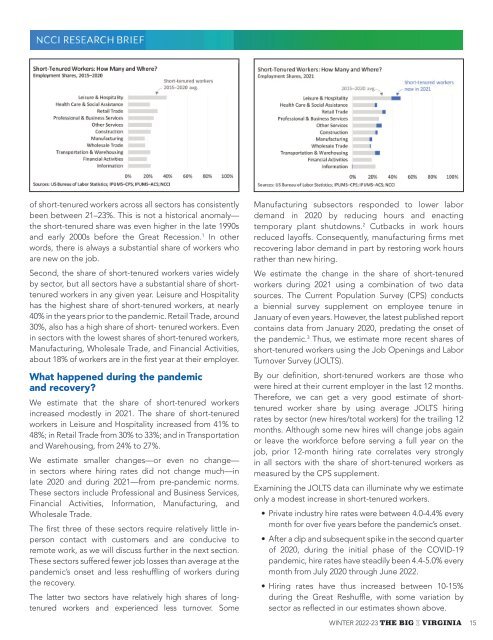The Big I Virginia Winter 2022-23
Create successful ePaper yourself
Turn your PDF publications into a flip-book with our unique Google optimized e-Paper software.
Introduction<br />
<strong>The</strong> Great Reshuffle is reshaping the US labor market. Unemployment is historically low, but labor force<br />
participation is still lower than the pre-pandemic rate. Labor shortages have led to wage growth, especially<br />
strong among low-wage workers and in sectors like Leisure and Hospitality.<br />
Quit rates jumped in the middle of 2021 and remain high at the time of this writing—about 50 million quits a<br />
year, almost 10 million more than pre-pandemic averages. Many workers are new to their jobs. Some of these<br />
are moving from one similar job to another, but others are changing industries or occupations. At the same<br />
time, there are a large number of new remote workers. Many people left the office at COVID’s onset; there has<br />
been a trickle back, representing a massive change in the amount of remote work compared to before the<br />
pandemic.<br />
of short-tenured workers across all sectors has consistently Manufacturing subsectors responded to lower labor<br />
been How between do such 21–<strong>23</strong>%. large changes This is not in the a historical labor market anomaly— impact demand workers compensation in 2020 by reducing injury frequency? hours and <strong>The</strong> enacting magnitude<br />
the of short-tenured these impacts share relies was on even the higher interaction the of late three 1990s factors: temporary plant shutdowns. 2 Cutbacks in work hours<br />
and early 2000s before the Great Recession. 1 In other reduced layoffs. Consequently, manufacturing firms met<br />
words, there • How is always much a more substantial or less share likely of are workers short-tenured who recovering or remote labor workers demand to be in injured part by than restoring other work workers? hours<br />
are new • on the How job. much has the share of such workers changed? rather than new hiring.<br />
Second, • the How share has of the short-tenured sector mix workers of the workforce varies widely changed We during estimate the the pandemic? change in the share of short-tenured<br />
by sector, but all sectors have a substantial share of shorttenured<br />
workers in any given year. Leisure and Hospitality sources. <strong>The</strong> Current Population Survey (CPS) conducts<br />
workers during 2021 using a combination of two data<br />
has the highest share of short-tenured workers, at nearly a biennial survey supplement on employee tenure in<br />
40% in the years prior to the pandemic. Retail Trade, around January of even years. However, the latest published report<br />
30%, also has a high share of short- tenured workers. Even contains data from January 2020, predating the onset of<br />
in sectors with the lowest shares of short-tenured workers, the pandemic. 3 Thus, we estimate more recent shares of<br />
Manufacturing, Wholesale Trade, and Financial Activities, short-tenured workers using the Job Openings and Labor<br />
about 18% of workers are in the first year at their employer. Turnover Survey (JOLTS).<br />
What happened during the pandemic<br />
and recovery?<br />
We estimate that the share of short-tenured workers<br />
increased modestly in 2021. <strong>The</strong> share of short-tenured<br />
workers in Leisure and Hospitality increased from 41% to<br />
48%; in Retail Trade from 30% to 33%; and in Transportation<br />
and Warehousing, from 24% to 27%.<br />
We estimate smaller changes—or even no change—<br />
in sectors where hiring rates did not change much—in<br />
late 2020 and during 2021—from pre-pandemic norms.<br />
<strong>The</strong>se sectors include Professional and Business Services,<br />
Financial Activities, Information, Manufacturing, and<br />
Wholesale Trade.<br />
<strong>The</strong> first three of these sectors require relatively little inperson<br />
contact with customers and are conducive to<br />
remote work, as we will discuss further in the next section.<br />
<strong>The</strong>se sectors suffered fewer job losses than average at the<br />
pandemic’s onset and less reshuffling of workers during<br />
the recovery.<br />
<strong>The</strong> latter two sectors have relatively high shares of longtenured<br />
workers and experienced less turnover. Some<br />
By our definition, short-tenured workers are those who<br />
were hired at their current employer in the last 12 months.<br />
<strong>The</strong>refore, we can get a very good estimate of shorttenured<br />
worker share by using average JOLTS hiring<br />
rates by sector (new hires/total workers) for the trailing 12<br />
months. Although some new hires will change jobs again<br />
or leave the workforce before serving a full year on the<br />
job, prior 12-month hiring rate correlates very strongly<br />
in all sectors with the share of short-tenured workers as<br />
measured by the CPS supplement.<br />
Examining the JOLTS data can illuminate why we estimate<br />
only a modest increase in short-tenured workers.<br />
• Private industry hire rates were between 4.0-4.4% every<br />
month for over five years before the pandemic’s onset.<br />
• After a dip and subsequent spike in the second quarter<br />
of 2020, during the initial phase of the COVID-19<br />
pandemic, hire rates have steadily been 4.4-5.0% every<br />
month from July 2020 through June <strong>2022</strong>.<br />
• Hiring rates have thus increased between 10-15%<br />
during the Great Reshuffle, with some variation by<br />
sector as reflected in our estimates shown above.<br />
WINTER <strong>2022</strong>-<strong>23</strong> THE BIG I VIRGINIA 15

















